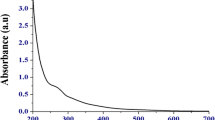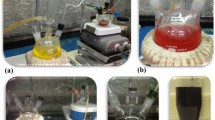Abstract
Quantum Dots (QDs) like Cadmium Sulphide have exciting applications, consequent to their size-dependent optical properties. This compound is used as a pigment in papers, paint, and it can also be found in solar cells. Due to the high use of nanoparticles in society, there is a significant concern in the scientific community about the potential toxicity of these nanomaterials in aquatic environments. According to this main problem, we have a theoretical assumption that Cadmium Sulphide (CdS) particles at nanoscale are more toxic than those in macroscale (bulk), and a higher concentration means higher toxicity. To verify its toxicity in the aquatic environment, first, we need to make sure the nanoparticles are soluble in water. Based in the mentioned before, the objectives of this research were: (i) synthesize Cadmium Sulphide QDs in aqueous phase in presence of biocompatible molecules like L-Glutathione and N-Acetyl-L-cysteine, (ii) characterize the quantum dots optically, structurally and morphologically and; (iii) evaluate the toxicity of Cadmium Sulphide in biological systems. CdS, L-Glutathione-covered CdS and N-Acetyl-L-Cysteine-covered CdS evidenced shoulder peaks at 473 nm (2.40 eV), 450 nm (2.62 eV) and, 381 (3.03 eV) nm, respectively. A broad and high emission peak centered at 545 nm was observed for CdS Nps covered with N-acetyl-L cysteine; whereas as QDs without cover and those covered with L-glutathione showed weak peaks in the visible range (470 nm-650 nm). The presence of L-Glutathione or N-Acetyl-L-cysteine on the quantum dots surface was verified by Infrared Spectroscopy. Energy Dispersive X-Ray Spectroscopy (EDX) assays evidenced the chemical composition of produced nanostructures having 57.91% of S and 42.09% of Cd. The morphology and the size were carried out by High-Resolution Transmission Electron Microscopy (HR-TEM). In this way, nanoparticles were spherical and with a size of ~3 nm. Toxicity results evidence that nanoparticles covered with N-Acetyl-L-Cysteine had a negative interaction in marine organisms at concentrations higher than 700 ppm, after 24 or 48 hours of contact. Also, CdS bulk showed absence of toxicity to marine crustaceans.
Similar content being viewed by others
References
I. Medintz, H. Mattoussi, A. Clapp, Int J Nanomedicine. 3(2), 151–167 (2008).
D. Vasudevan, R. Gaddam, A. Trinchi, I. Cole, J. Alloys Compd. 636, 395–404 (2015).
A. Malathi, M. Jagannathan, J. Nano. Res-Sw. 48, 49–61 (2017).
L. Shangxi, M. K. Wong, P. K. Pat, C. Y. Wong, S. K. Chiu, E. Pun, J. Phys. Chem. 115 (44), 21604–21609 (2016).
L. O. Cinteza, J. Nanophotonics. 4(1) (2010).
R. Tarrahi, A. Movafeghi, A. Khataee, F. Rezanejad, G. Gohari, Molecules. 24(3): 410 (2019).
N. Bandow, F. G. Simon, Environ Sci Eur. 28(1) (2016).
R. Hardman, Environ. Health Perspect. 114, 115–172 (2006).
A. Bruneau, M. Fortier, F. Gagne, C. Gagnon, P. Turcotte, A. Tayabali, T. L. Davis, M. Auffret, M. Fournier, Environ. Sci. Process Impacts. 15(3), 596–607 (2013). au[10]_R. Rotomskis, Ž. Jurgelėnė, M. Stankevičius, M. Stankevičiūtė, N. Kazlauskienė, K. Jokšas, D. Montvydienė, V. Kulvietis, V. Karabanovas, Sci. 63, 1280–1291 (2018). au[11]_R. F. Domingos, D. F. Simon, C. Hauser, K. J. Wilkinson, Environ. Sci. Technol. 45(18), 7664–7669 (2011). au[12]_J. Velázquez, & S. Bailón-Ruiz, MRS Adv. 4(38-39), 2095–2102 (2019). au[13]_M. N. Borovaya, A. P. Naumenko, N. A. Matvieieva, Y. B. Blume, A. I. Yemets, Nanoscale Res Lett. 9 (686), (2014). au[14]_F. Petrucci, S. Caimi, G. Mura & S. Caroli, Microchem J. 51(1-2), 181–186 (1995)
Author information
Authors and Affiliations
Rights and permissions
About this article
Cite this article
Chaparro Barriera, E.A., Bailón-Ruiz, S.J. Fabrication, Characterization, and Nanotoxicity of Water stable Quantum Dots. MRS Advances 5, 2231–2239 (2020). https://doi.org/10.1557/adv.2020.260
Published:
Issue Date:
DOI: https://doi.org/10.1557/adv.2020.260




